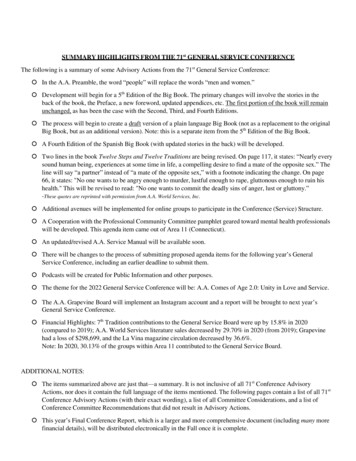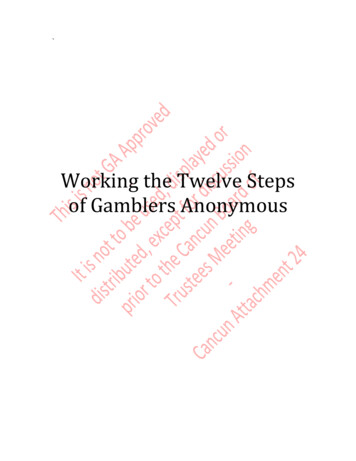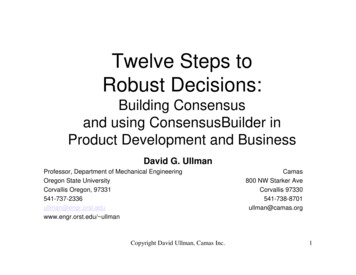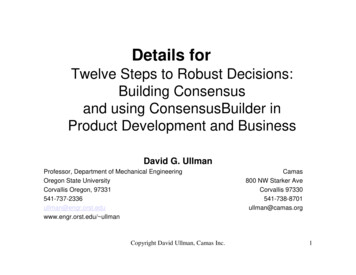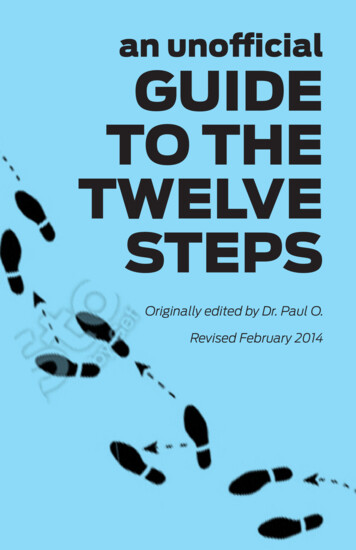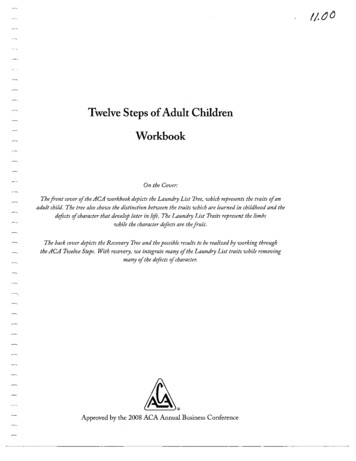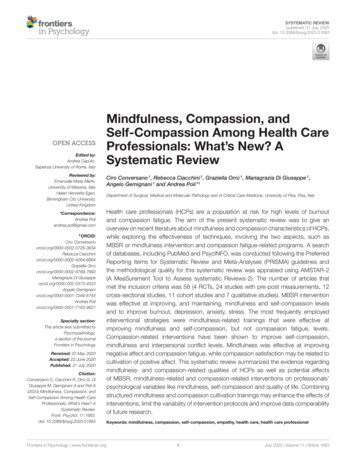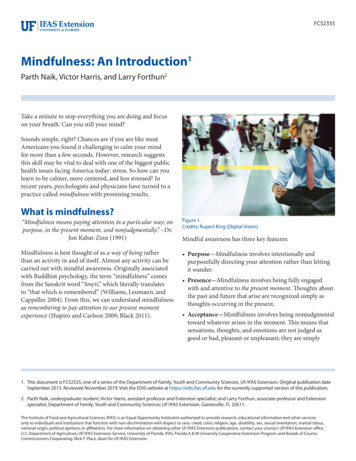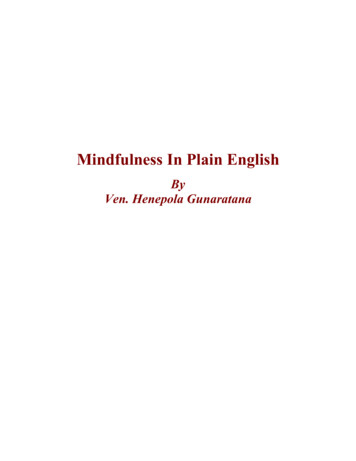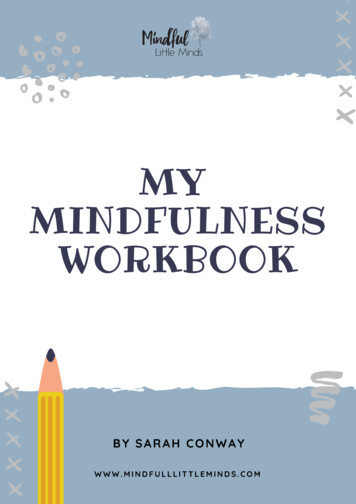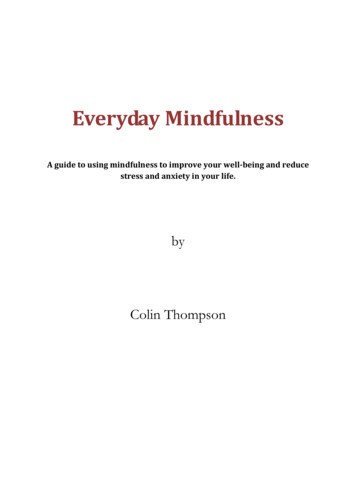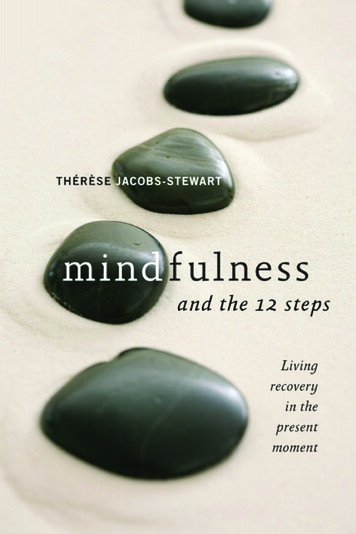
Transcription
Mindfulness and the 12 Steps
Mindfulness and the 12 Steps Thérèse Jacobs-Stewart
HazeldenCenter City, Minnesota 55012hazelden.org 2010 by Thérèse Jacobs-StewartAll rights reserved. Published 2010Printed in the United States of AmericaNo part of this publication may be reproduced, stored in a retrieval system, ortransmitted in any form or by any means—electronic, mechanical, photocopying,recording, scanning, or otherwise—without the express written permission of thepublisher. Failure to comply with these terms may expose you to legal action anddamages for copyright infringement.Library of Congress Cataloging-in-Publication DataJacobs-Stewart, Thérèse.Mindfulness and the 12 steps / Thérèse Jacobs-Stewart.p. cm.Includes bibliographical references.ISBN 978-1-59285-820-0 (softcover)1. Twelve-step programs—Religious aspects—Buddhism. 2. Religious life—Buddhism. 3. Self-help techniques. I. Title. II. Title: Mindfulness and the twelvesteps.BQ4570.T85J33 2010294.3'376229—dc22Editor’s noteThe names, details, and circumstances may have been changed to protect theprivacy of those mentioned in this publication.This publication is not intended as a substitute for the advice of health careprofessionals.Alcoholics Anonymous, AA, and the Big Book are registered trademarks ofAlcoholics Anonymous World Services, Inc.14 13 12 11 10 1 2 3 4 5 6Cover design by PercolatorInterior design and typesetting by Madeline Berglund
Also by Thérèse Jacobs-StewartPaths Are Made by Walking:Practical Steps for Attaining Serenity
Idedicate this book to the people who attendthe Twelve Steps and Mindfulness meetings at MindRoads Meditation Center in Saint Paul, Minnesota.We were inspired by the Meditation in Recovery groupat San Francisco Zen Center, which in turn rests uponthe awakening of countless beings going all the wayback to the Buddha. In each moment of the unfoldingconversation about recovery and mindfulness, we aresupported by them. May wisdom, compassion, andserenity arise in all.
As a blind man feelswhen he finds a pearl in the dust-bin,so am I amazed by the miracle of awakeningrising in my consciousness.From the “Bodhicharyavatara” by Shantideva1
CONTENTS Preface . . . . . . . . . . . . . . . . . . . . . . . . . . . . . . . . . . . . . . . . . . . . . . . . . . . . xvAcknowledgments . . . . . . . . . . . . . . . . . . . . . . . . . . . . . . . . . . . . . . . . . . xvii1. Joining the Great We . . . . . . . . . . . . . . . . . . . . . . . . . . . . . . . . . . 1Four Pure Insights . . . . . . . . . . . . . . . . . . . . . . . . . . . . . . . . . . . . . . 4Releasing the Delusion of Separateness . . . . . . . . . . . . . . . . . . . . . . 6Admitting Our Suffering, Opening to Community . . . . . . . . . . . . . 9Entering the Field in the Fellowship of Others . . . . . . . . . . . . . . . 10Mindfulness Practice for Step One: Resting in the Fieldof Awakened Ones . . . . . . . . . . . . . . . . . . . . . . . . . . . . . . . . . . . 112. Coming To . . . . . . . . . . . . . . . . . . . . . . . . . . . . . . . . . . . . . . . . . . . . 15Seeing Our Internal Response to Events . . . . . . . . . . . . . . . . . . . . 17Awakened Beings Are Just like You and Me . . . . . . . . . . . . . . . . . . 20Restored to Sanity by Touching Our “True Face” . . . . . . . . . . . . . 21Accessing Our True Nature through a Still Mind . . . . . . . . . . . . . . 22Mindfulness Practice for Step Two: Prepare for Sitting . . . . . . . . . 24Mindfulness Practice for Step Two: Breathingand Noting Meditation . . . . . . . . . . . . . . . . . . . . . . . . . . . . . . . 253. Taking Refuge . . . . . . . . . . . . . . . . . . . . . . . . . . . . . . . . . . . . . . . . 27Step Three as Taking Refuge in the “Three Gems” . . . . . . . . . . . . . 29Taking Refuge in Awakening (Buddha) . . . . . . . . . . . . . . . . . . . . . 31Taking Refuge in the Path of Mindfulness, Understanding,and Love (Dharma) . . . . . . . . . . . . . . . . . . . . . . . . . . . . . . . . . . 34Taking Refuge in Community (Sangha) . . . . . . . . . . . . . . . . . . . . 36Mindfulness Practice for Step Three: Three Refuges Prayer . . . . . 404. Entering the Green Dragon’s Cave . . . . . . . . . . . . . . . . . . . . 43Three Sources of Shame . . . . . . . . . . . . . . . . . . . . . . . . . . . . . . . . . 45Entering the Dragon’s Cave—a Path beyond Shame . . . . . . . . . . . 48xi
C o n te n t sxiiFacing Our Ambivalence about Step Four . . . .The Eightfold Path as a Moral Inventory . . . . .Mindfulness Practice for Step Four: Inventoryof the Eight Gates . . . . . . . . . . . . . . . . . . . . . . . . . . . . . . . . . .4953. . . . . . . . . . . . . . .55. . . . . . . . . . . . . . .5. Placing Ourselves in the Cradle of Kindness . . . . . . . . . . 63A Release from the Burden of Self . . . . . . . . . . . . . . . . . . . . . . . . . 65Step Five as Loving Kindness . . . . . . . . . . . . . . . . . . . . . . . . . . . . . 67Growing Loving Kindness through Meditation . . . . . . . . . . . . . . . 70The Ancient Structure of Call-and-Response . . . . . . . . . . . . . . . . 71Mindfulness Practice for Step Five: LovingKindness Meditation . . . . . . . . . . . . . . . . . . . . . . . . . . . . . . . . . 726. Turning Over a New Leaf . . . . . . . . . . . . . . . . . . . . . . . . . . . . . 77Cutting through Confusion with Awareness . . . . . . . . . . . . . . . . . 78Seeing the Anatomy of a Character Defect . . . . . . . . . . . . . . . . . . 79Defects as Delusions—the “Daughters of Mara” . . . . . . . . . . . . . . 82The Delusion of Skandha-Mara—a Distorted Sense of Self . . . . . 83The Delusion of Klesha-Mara—Unskillful Responsesto Emotions . . . . . . . . . . . . . . . . . . . . . . . . . . . . . . . . . . . . . . . . 84The Delusion of Devaputra-Mara—Escaping into Pleasure . . . . . 87The Delusion of Yama-Mara—Thinking We’re in Control . . . . . . 88Recognizing Our Delusions . . . . . . . . . . . . . . . . . . . . . . . . . . . . . . 89Asking God to Remove Defects Starts with Mindfulness . . . . . . . . 93Mindfulness Practice for Step Six: How Does Mara Hook You? . . 937. Vowing with the Help of All Beings . . . . . . . . . . . . . . . . . . . 97Hitting the Pause Button . . . . . . . . . . . . . . . . . . . . . . . . . . . . . . . . 98Step Seven as Touching Our Buddha Nature . . . . . . . . . . . . . . . . . 99The Power of Aspiration . . . . . . . . . . . . . . . . . . . . . . . . . . . . . . . 100Aspiration and Determination Create Our Vow . . . . . . . . . . . . . 102Releasing Shortcomings through Vows . . . . . . . . . . . . . . . . . . . . 103Examples of Vows . . . . . . . . . . . . . . . . . . . . . . . . . . . . . . . . . . . . . 104Mindfulness Practice for Step Seven: Write a Personal Vow . . . . . 1068. Finding Pearls in the Dust-Bin . . . . . . . . . . . . . . . . . . . . . . . 109Seeing Our Shadow, Ending Our Isolation . . . . . . . . . . . . . . . . . 111Just the Right Amount of Remorse . . . . . . . . . . . . . . . . . . . . . . . 113
C o n te n t sxiiiStarting with the Smallest Desire to Make AmendsMaking Direct Amends Wherever Possible . . . . . .Making Amends by Speaking Up . . . . . . . . . . . . . .Experiencing the Grace of Forgiveness . . . . . . . . .Mindfulness Practice for Steps Eight and Nine . . . . . . . . . . . . . . . . . . . . . . . . . . . . . . . . . . . . . . . . . . . . . . . . . . . . .1161181201211229. Standing on the Ground of Our Deeds . . . . . . . . . . . . . . . 125Three Times to Reflect on Our Actions . . . . . . . . . . . . . . . . . . . . 126Taking an Evening Inventory with Naikan Practice . . . . . . . . . . . 132Mindfulness Practice for Step Ten: Taking a Naikan Inventory . . 13910. Making Conscious Contact . . . . . . . . . . . . . . . . . . . . . . . . . . 143Breathing into Prayer and Meditation . . . . . . . . . . . . . . . . . . . . . 145Going against the Grain of Unmindful Living . . . . . . . . . . . . . . . 146Watering the Seeds of Our Buddha Nature . . . . . . . . . . . . . . . . . 147Living from a Full Cup . . . . . . . . . . . . . . . . . . . . . . . . . . . . . . . . . 148No Striving—Just Sit . . . . . . . . . . . . . . . . . . . . . . . . . . . . . . . . . . 152Conscious Contact Lets Our True Self Emerge . . . . . . . . . . . . . . 153Mindfulness Practice for Step Eleven . . . . . . . . . . . . . . . . . . . . . . 15511. Remembering Our True Face . . . . . . . . . . . . . . . . . . . . . . . . 163Awakening the Mind of Love . . . . . . . . . . . . . . . . . . . . . . . . . . . . 164Two Levels of Bodhichitta . . . . . . . . . . . . . . . . . . . . . . . . . . . . . . 166Awakening in the Space between Thoughts . . . . . . . . . . . . . . . . . 167Notes . . . . . . . . . .About the Author. . . . . . . . . . . . . . . . . . . . . . . . . . . . . . . . . . . . . . . . . . . . . . . . . . . . . . . . . . . . . . . . . . . . . . . . . . . . . . . . . . . . .171183
P R E FAC E We meet Monday evenings at Mind Roads Meditation Center in SaintPaul, Minnesota, one chapter in a nationwide community of Twelve Stepsand Mindfulness meetings. The room is soft with candlelight, scented byburning incense, and lined with black cushions on the polished oak floor.Our addictions are widespread: drugs, alcohol, food, gambling, cigarettes,or codependency. Everyone is welcome.We introduce ourselves by going around the circle, saying our first nameand Twelve Step affiliation. We have a common interest in meditationpractices and how they can inform our recovery from addiction. Eachmonth, we discuss one of the Twelve Steps and how Buddhist thought,meditation, and mindfulness practice can be applied to our life in recovery.We sit in silent meditation together, hear a talk by one of our members,and share our reflections.As with many Twelve Step meetings, we are a diverse group of people,tall and short, wide and thin, black and white and brown. BMW sedans areparked next to rusty pickup trucks in the parking lot.Yet we are part of the great stream of beings seeking deeper serenity inour lives, grounded in sobriety by the Twelve Step program, inspired toawaken and live in the present by the practices of mindfulness meditation.In our addictions, we were never here in the moment. We wanted to begone. Now we are learning to wake up to the joy of being alive.Once a month for the past five years, I have given a talk to our Mondaynight group. The following chapters are your virtual seat in our meeting.Please make yourself at home.xv
AC K N O W L E D G M E N T S The mind, hearts, and energy of many people contributed to the seedingof this book in me and its manifestation in the written form you now holdin your hands.Bowing in thanksgiving to:My loved ones, including: Jim, my dearest friend and partner of thirtyyears, and Cathie and Ted Furman, for their undying enthusiasm and care.My fellow writers: Lindsay Nielsen, Sue McCauley, Astrid Slungaard,Darla Garvey, and Donna Karis, for their inspiration and invaluable feedback; my editors, Doug Toft and Sid Farrar, for their tremendous skill andthe pure pleasure of working with them.My spiritual advisers: Father Michael Winterer, Sister Mary SharonRiley, Thrangu Rinpoche, Tenshin-roshi Reb Anderson, and Eijun LindaRuth Cutts, for their deep wisdom and teachings.Jenny, Krista, and Olga, for their gracious support and many wonderfulcups of chai tea.May the merits of this book be of benefit to them.In keeping with the tradition of anonymity and confidentiality in theTwelve Step program, names of people mentioned in this book have beenchanged, along with details that would identify them.xvii
1Joining the Great WeWe admitted we were powerlessStep One over alco h o l that our lives hadbecome unmanageable.I woke up in the isolation ward.Doctor Schultz, tall, lean, and wrinkled with time, squinted throughthick glasses. When he treated my grandmother, he used to make housecalls. Now, he poked and prodded with gloved hands, head to toe in surgicalblue, grunting monosyllabic comments.“What’s wrong with me?” I asked.“You are very ill.”“Can you make me better?”“I’m trying.”The initial diagnosis was spinal meningitis, and the treatment wasseveral days lying on a bed of ice to lower the 104-degree fever. Later, thediagnosis was revised to a severe case of mononucleosis. The old-schoolDoctor Schultz never asked if I had run myself into the ground by usingdrugs, and I didn’t whisper a word. Not until week four of the hospital staydid it inkle through my mind, Could it be that I collapsed because of takingall that speed?1
2M i n d f u l n e s s a n d t h e 1 2 S te p sThe moment of awareness stands still in time. Two years and then someof nearly daily use, popping white crosses and other street junk to keepgoing, working three jobs to make grades and tuition and rent. I went to aprivate college I didn’t want to go to, kept up a high grade-point averagebecause I had to. My father expected no less. But amphetamines erased alllimitations. I could do anything, never had to sleep, was the life of theparty. It was marvelous, magnificent, drug-induced bliss.Doctor Schultz told me to take a semester off from college. He said I hadto put some weight back on, get eight hours of sleep every night, and takevitamins. I was burned out at twenty-two years old. I didn’t want to stopusing, but I was scared of dying. On the other hand, it wasn’t exactly like Iwanted to live.My girlfriend’s guy friend, Skip, went to Alcoholics Anonymous (AA)meetings. I asked him what he thought I should do. He said maybe meetup with him at AA sometime; most people stop their drug use before theyend up in the hospital for a month, their health in shambles.I said I’d think about it.I loved that gold camaro but the tires were jinxed. They slid on theblack ice hidden beneath the snow, bumping the curbside and blowing atire. The cold weakened the seal, leaking air. Even the new radial tiresdidn’t help. It was the sixth flat tire so far that year, and it was still cold asa bitch. Bummer. If not for that tire, I might have sat in front of the churchfor a while and then driven away. But I had to go in and ask for help to puton the spare. The bitter windchill made my hands too stiff to manage italone.Saint Matt’s Episcopal Church is on the north side of Lake of theIsles, warm and bright and hung with colored lights. “’Tis the season,”December 27, 1975. The sting of cigarette smoke hits as I walk in, hazy,stinky air. Voices jingling with laughter, underscored by raspy, hackingsmokers’ coughs. A stranger comes up, right hand extended.“Hi, are you new? Is it your first time here? Grab a cup of java over thereby the kitchen window.”Friendly, happy people are hugging and slapping each other on theback. Lots of friendly, happy people. What the hell is wrong with them? Butit’s kind of nice, comforting. Maybe I will stay for the meeting after all.
J o i n i n g t h e G r e a t We3There’s the little flat tire problem to deal with. Skip said he’d meet me here,and I don’t want to stand him up.Six months after my health breakdown, I’d made it to my first TwelveStep meeting of Alcoholics Anonymous.I kept going, at first because hanging with people and having coffeeafter the meeting was fun. And I loved the anonymous part of the meetings. Nobody had to know anything about me. I was safe. I could just comein, sit down, and belong. People were accepting, encouraging, and inspiring. They weren’t the losers I thought they would be. It was surprising,unsettling really, to hear people talk openly about their struggles and fears.I had a place with this group of other misfits.I kept coming back, hoping it would somehow do some good, yearningfor the serenity others seemed to have. I wanted to change but didn’t knowhow. People didn’t change in my family.I come from, I now know, generations of Irish alcoholics. At leastfour generations of alcoholics, way back to the “old country.” On my firstvisit to Ireland, when I was piecing together my family tree for a project ingraduate school, I tracked down my father’s second cousins. I learned thatdear old Grandpa didn’t come to the United States because of the potatofamine after all. He was in trouble with the law, sloppy drunk and knocking over gravestones, getting into brawls at the pubs. He fled the country,bringing his temper with him. His father before him was an alcoholic. Halfthe family in the old country was alcoholic. Half the family in this countryis alcoholic.And there it is: a whole painful, lonely, shame-based, violent family tree.“We” meant being doomed—genetically wired to self-destruct. Walkinginto that first meeting was an admission that I needed help, couldn’t do italone anymore. Had there been any other way, I would have passed.Now, thirty-five years later, I owe the programs of Alcoholics Anonymousand Al-Anon my life. I’ve stayed straight and can say I am genuinely happy.My wake-up call at the age of twenty-two was a life-changing “failure.” Themigraines, ulcerative colitis, and dependency on pills are gone. I confessthat abstinence from drugs, in and of itself, was not all that difficult. Themuch harder part has been learning how to live sober.The Twelve Step program opened access to an inner spiritual life—a
4M i n d f u l n e s s a n d t h e 1 2 S te p spart of me sealed shut, bitter and hard from my Catholic upbringing.After several years in recovery, I became keenly interested in mindfulnessand meditation. By chance, I read Lillian Roth’s biography, I’ll CryTomorrow, the story of her decline and recovery from alcoholism. Shementions an Inter-Group pamphlet published in the 1950s, which outlined similarities between the Twelve Steps and a set of contemplativepractices from the sixteenth century, the Ignatian Exercises. These are a setof prayers, visualizations, and “thought experiments” to be carried out ina retreat setting under the guidance of a spiritual director. The exercises arebased on the experiences of Saint Ignatius of Loyola, who offered them asa way to discover God’s will and carry it out in our daily lives. I had neverheard of them, despite decades of Catholic education. None of my friendsin the program had heard of them either.Eventually I discovered the Cenacle House in Wayzata, Minnesota, alocal contemplative center offering a yearlong retreat on the IgnatianExercises. I signed up in an instant, motivated by what I thought was sheercuriosity. I think now there might have been something more to it, perhapsa deep thirst, a need to find lasting happiness.The Ignatian retreat started a spiritual journey that has taken me to manyplaces and has inspired practice and study with many people. I continued totrain at the Cenacle House during the next ten years, gaining a certificatein spiritual direction. Also, I was interested in Eastern contemplativepractices and traveled to study meditation in India, Nepal, and ZenBuddhist monasteries in the United States. I completed graduate studiesin psychology and became licensed to practice as a psychotherapist.These threads, together with the Twelve Steps, wove my recovery fromdrug dependency and helped mend the effects of growing up in a violent,chaotic, alcoholic family.Four Pure InsightsIn recovery, I grappled with the reality of suffering, the thing I hated aboutlife and sought to escape with drug use. I wondered: What’s wrong withme? How did I end up addicted to drugs, despite never wanting to be likemy alcoholic father? Why do I hurt so bad and feel like I have a hole in myheart that will never heal?
J o i n i n g t h e G r e a t We5In meditation classes I was introduced to the Four Pure Insights into theWay Things Are, a Buddhist teaching that shed light on these questions.1Sometimes called the Four Noble Truths, the text became an importantsource of comfort and relief in my recovery.Four Pure Insights into the Way Things Are, among Gautama Buddha’searliest teachings, were given shortly after his monumental awakening undera bodhi tree. He had spent his entire adult life roaming the countryside,trying to come to grips with the reality of suffering in the world. Heabandoned his family’s wealth, kept no earthly possessions, fasted, meditated, and pursued understanding truth. Once enlightened, the Buddhataught about four principal realities of suffering.The First Insight: SufferingThe first insight is that suffering is an intrinsic part of life. (The Pali wordfor suffering is dukkha, translated as a “thirst” or “unsatisfactoriness” thatdoes not go away.) Life serves it up in one form or another. Dukkha isn’tanybody’s fault. It just is. Attempting to push away or control the uncontrollable is folly.In hearing this insight, I have an image of the Buddha looking and sounding like a counselor from the PharmHouse treatment center in the 1970s, inplaid shirt, torn blue jeans, and a long ponytail, saying “So, deal with it!”We face the truth of Gautama Buddha’s first teaching in the First Stepof the Twelve Step program, admitting we are powerless over alcohol (andalcoholics)—that denying and trying to manage our addictive mind isunmanageable. Buddha says this too: dukkha, or thirst, is inexhaustible.For Twelve Steppers, our dukkha is addiction and codependency. Forothers it may come in other forms, such as change, illness, loss, or death.But it comes.The Second Insight: Our Response to SufferingThe second reality, or “truth,” is that we have an internal response to thedukkha we encounter. For every external event that arises, we have aninternal reaction that co-arises. Some of our reactions cause or compoundthe suffering already there. Examples include numbing out with drugs oralcohol, blaming ourselves or others, and trying to manage and control
6M i n d f u l n e s s a n d t h e 1 2 S te p sanother person. We have our own personal brand of insanity, alive andwell and inside of us, not “done to us” by others.Buddha, like the founders of the Twelve Step program of recovery,encourages rigorous personal honesty and self-observation. He taughtpractices of mindfulness meditation to develop greater self-knowledge andself-control.The Third Insight: Transforming Our ResponseThird, we aren’t doomed or stuck; we don’t have to keep on suffering.Buddha says it is possible to transform our internal responses to the outside events we cannot control. Western neuroscience has confirmed thisnoble truth, showing in before-and-after brain scans that an ongoing practice of mindfulness and loving kindness meditation changes our brainchemistry and activates our left prefrontal lobe, the brain’s “happinesscenter.”2 If we are willing to deeply engage in spiritual practice, we willchange, even down to the cellular level.The Fourth Insight: A Path to TransformationThe final insight is that there is a path out of suffering. The concrete practices of mindfulness, loving kindness meditations, and ethical living openthe way to a life of greater peace and happiness.3 The Twelve Step recoveryprogram gives us specific steps to follow, practices that are amazinglysimilar, in spirit if not in language, to those of Buddhism.Further, the Buddha says it is noble to stay with our human experienceof suffering. Through it we connect with the all other beings, a great joy.What? Usually, suffering shrinks our world, occupied only by me andmy misery, thank-you-very-much. When dukkhas (“thirsts”) such as loneliness, addictive cravings, or angry feelings take hold, we get lost in ourown bubble of pain and separateness. Buddha’s insight was that believingwe are unique and alone is a basic human delusion.Releasing the Delusion of SeparatenessThe double life of my addiction created a wall between me and others.Between the ages of sixteen and twenty-two, I used regularly, but secretly,
J o i n i n g t h e G r e a t We7and was proud of it. I maintained an honor-roll grade-point average, nevermissed a payment for my Camaro, and worked three part-time jobs to paymy college tuition. (Okay, so I was late to work a few times. Maybe morethan a few times. Maybe I didn’t show up once in a while . . .) Outside,solid citizen. Inside, jumbled-up head case. Ulcerative colitis, migraineheadaches, anxiety, and a closet amphetamine user. No one had a clue untilI broke down and landed in the hospital. It had been a quiet, hidden pathof utter self-destruction.When I heard the First Step of Alcoholics Anonymous, “We admittedwe were powerless over alcohol [and drugs]—that our lives had becomeunmanageable,” the we word was like the sound of a foreign tongue.Strange. Unfamiliar. Like a pungent, tart lemon drop: your eyes water fromthe sour taste. Then you want another one. Although I recoiled from theidea of being part of a “we,” I yearned for it too.In Twelve Step meetings, I was surprised to hear how many others felt cutoff and alone too. Even the delusion of separateness is a shared delusion.Tenshin-roshi Reb Anderson, senior dharma teacher at San Francisco ZenCenter, says it like this: “You think that everybody’s in the whole big worldout there, and then there’s this little separate bump over here and that’syou.”4I first heard him talk about this nearly fifteen years ago. At that time Ithought, “You bet that’s the way it is. No doubt about it.” In my family, Ifelt not only separate but more grown-up than my parents.We, meaning my sisters and me, were attempting to get my fatherrecommitted for alcohol treatment. It would be the eleventh time.My younger sister, Anne, called in the middle of the night, sobbing infear and anger. “He’s pounding on the door, hollering and swearing at me.The lock is going to give. Mother is in bed with a headache.”The usual story. She was in danger; he would hurt her. He was violentwhen he was drunk, funny and charming when sober. A pillar of thechurch community.“Crawl out the window and run to the corner of the block, next to theSims’s house,” I said. “Bring your clothes and stuff for school. Watch formy gold Camaro. I’ll be there to pick you up in about thirty minutes. Don’ttry to talk Mother into coming with you. Just leave.”
8M i n d f u l n e s s a n d t h e 1 2 S te p sI lived in an apartment by Lake Calhoun with my sister Cecile, twoyears my senior, both of us under twenty. That weekend, as the three ofus talked, we decided it had to be done. Our plan was to call the socialworker in charge of his case and sign papers to have the court send myfather back to Anoka State Hospital. It was a wrenching decision.Anoka State Hospital stunk with all the crazies peeing in their pantsand not enough staff to take care of them. The food was gross. The courthad sent Dad there for his tenth treatment, because he was violent, hadthreatened us, and then tried to kill himself with his gun. The judgecould bounce him back in with the stroke of a pen. We all three swore tostand together, no matter how tough it got.After a few days, Anne insisted on going back home. She wanted to sleepin her own bed, see her friends at school. She promised not to tell Momwhat we were planning. Once the judge signed the papers, the sheriff ’sdepartment would “escort” my father to the hospital. No doubt it wouldbe another ugly scene. Last time they dragged him away in a straitjacket,hollering like a wounded wolf. All the neighbors heard, I’m sure.The following Friday afternoon the social worker called. Cecile hadchickened out, refused to sign the commitment papers. Anne was legallystill a minor, so I was it. The woman informed me that no one was homewhen the sheriff arrived at my parents’ home that morning. I would laterfind out that Anne, feeling bad for Dad and scared of the possible repercussions of our plan, had spilled the works. My mother drove my fatherto Canada for the weekend to escape.The social worker enunciated slowly, each word firm and to the point:“I don’t think there is anything more you can do. It’s obvious your fatherdoesn’t want to get treatment, your mother’s enabling him, and your sistersdo not agree with what you are doing. You need to give it up. Get a life. Goto Al-Anon.”I hung up, numb. Then I lay on the floor of the living room, unable toget up—cocooned in despair, alone, a bump on the side of the road whilethe rest of life passed by.
J o i n i n g t h e G r e a t We9Admitting Our Suffering, Openingto CommunityPerhaps many of us have dragged ourselves through the door of our firstTwelve Step meeting, frustrated, impotent to change the addicts or alcoholics we love, admitting by our very presence that going it alone hadfailed us. Humiliated, perhaps, to let our hurt show, or to disclose we areout of control—powerless to handle our own drug or alcohol use, powerless to cure our alcoholic loved ones, powerless to manage others in anyway. Striving for perfection, hiding our real self from others, or putting ona false face keeps us separate and alone.But in the act of admitting our pain and suffering, we open up to acommunity. When we admit our failures, weaknesses, hurts, and needs, wefind out we are not alone. A portal to connecting with others is opened.Thích Nhất Hanh—a Vietnamese monk and, I believe, a holy person onthis earth—describes it this way: “We have to recognize and acknowledgethe presence of suffering and touch it. Please don’t run away from suffering. Embrace it and cherish it. To do so, we need the help of friends in thepractice.”5A fundamental teaching of mindfulness and Buddhism is that we areinterconnected with all beings, all life forces. Believing we are separate, thatI do not affect you and you do not affect me, is a delusion.This is depicted in the story of Gautama Buddha’s moment of enlightenment, which goes something like this: Gautama is sitting under abeautiful bodhi tree, meditating and maybe chanting “Ohm” after yearsof wandering, searching, and nearly starving to death. He is wrestlingwith his inner demons, watching them torture his mind. He touches theground with his fingers, and as he does, the earth rumbles, rising to meethim. All of his suffering a
Mindfulness and the 12 steps / Thérèse Jacobs-Stewart. p. cm. Includes bibliographical references. ISBN 978-1-59285-820-0 (softcover) 1. Twelve-step programs—Religious aspects—Buddhism. 2. Religious life— Buddhism. 3. Self-help techniques. I. Title. II. Title: Mindfulness and the twelve

